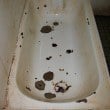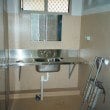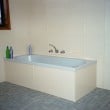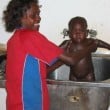B1.4 Washing kids ― hand basin, baths, and laundry tubs
Regular washing of children can prevent the spread of disease and improve health. Every house requires at least one facility where babies and young children can easily be washed. Ideally, this would include a tub for washing babies and a bath for washing children.
Ceramic hand basins are usually too small for washing babies and plastic baby baths may not be available in the local store. Residents often use the laundry tub to wash young children because it is large and at a good height. Many laundry tubs have washing machine bypass drains ensuring that the washing machine wastewater does not pass through the tub. This reduces the chances of the dirty washing water contacting the young child.
If incorporating a separate bathtub in the wet area, avoid using a combination shower/bath as this can be difficult and dangerous to use, particularly for older people or people with disabilities. Plan the bathroom to allow an adult to attend to at least two children in the bathtub at once. Set out the bathroom for maximum accessibility for a person with limited mobility. When specifying a bathtub, consider durability, size and how it will fit within the overall wet area layout.
Data shows that the laundry tub provides the greatest opportunity to wash a small child, with 92% of houses having a secure laundry tub. Bathtubs are available in more than half of all houses (59%).
Although 68% of houses had at least one hand basin, the small size of the basin and the close proximity of taps and spout may make the hand basin difficult to use to wash babies.
Design and Specification
Ensure
- B1.4.1.
facilities are available for washing children in every house, including either a large hand basin, laundry tub or easily accessible bathtub, with tempered hot water, cold water and drainage to a waste water drainage system
- B1.4.2.
to allow the safe washing of a child in a laundry tub, a working washing machine wastewater bypass to separate the child from any washing machine grey water discharge
- B1.4.3.
bathtubs, hand basin and laundry tubs are fitted in accordance with local regulations
- B1.4.4.
the specification requires the builder to provide a warranty for the waterproofing of the bathroom area
- B1.4.5.
the specification requires a manufacturer’s warranty for the bath tub, hand basin and laundry tub
Consider
- providing a 70 litre flush line tub with hot and cold water supply in the laundry or bathroom, set into a bench top, which will provide space for changing nappies, drying and dressing a child
- alternatively, providing a larger hand basin in the bathroom to wash a baby
- when providing a tub in the laundry, specifying a bypass drain for the washing machine to prevent dirty waste water from the washing machine flowing into the laundry tub
- using a swivel spout and locating taps to prevent injury to children being washed in the laundry tub
- connecting the laundry taps to the hot water tempering device to prevent scalding, particularly if the laundry tub taps will also be used for hand washing or for washing children
- providing a bath tub for washing children
- fitting a grab rail around the bath for children and elderly people to safely step in and out of the bath
- providing a bench/seat near the bath for drying and dressing a child
- using a chain to secure the tub/bath plug
- providing a soap holder, shelves out of reach of children, towel rails, grab rails and hooks near the bath and/or tub
- incorporating a separate bathtub in the wet area, and avoiding a combination shower/bath as this can be difficult and dangerous to use, particularly for older people or people with disabilities.
Real world examples of Solutions
- B1.4.1.
Quality control
- there is hot and cold water supplied to the tub and that the bath, taps and spouts do not leak

- AT HANDOVER
FINAL COMPLETION
TRADE TEST
- AT HANDOVER
- drainage is connected to the hand basin / laundry tub / bathtub and does not leak

- AT HANDOVER
FINAL COMPLETION
TRADE TEST
- AT HANDOVER
- the laundry tub is fixed and well sealed to the wall or bench

- DURING CONSTRUCTION
AT HANDOVER
FINAL COMPLETION
- DURING CONSTRUCTION
- the bath tub has been securely supported at the base and water-proofed to adjoining walls

- DURING CONSTRUCTION
AT HANDOVER
FINAL COMPLETION
- DURING CONSTRUCTION
- mould resistant silicon is used to seal laundry tubs and bath tubs to wall surfaces

- DURING CONSTRUCTION
AT HANDOVER
FINAL COMPLETION
- DURING CONSTRUCTION
- the wall behind the laundry tub and/or bath has been waterproofed and lined with a water impervious surface such as wall tiles, laminated sheet, sheet vinyl or stainless steel, which is sealed to the bathtub, laundry tub hand basin and bench

- DURING CONSTRUCTION
AT HANDOVER
- DURING CONSTRUCTION
- the bath tub, hand basin or laundry tub are not cracked or damaged

- AT HANDOVER
FINAL COMPLETION
TRADE TEST
- AT HANDOVER
- a swivel spout is fitted if specified

- COMPLETED DESIGN & SPECIFICATION
DURING CONSTRUCTION
AT HANDOVER
FINAL COMPLETION
- COMPLETED DESIGN & SPECIFICATION
- there is a plug, secured on a chain to the bath tub, hand basin or laundry tub

- AT HANDOVER
FINAL COMPLETION
- AT HANDOVER
- a bypass drain is provided for the washing machine in the laundry tub wastewater plumbing connection or by a separate wastewater pipe.

- COMPLETED DESIGN & SPECIFICATION
DURING CONSTRUCTION
AT HANDOVER
- COMPLETED DESIGN & SPECIFICATION
- there is hot and cold water supplied to the tub and that the bath, taps and spouts do not leak
Maintenance
As part of cyclical maintenance, check that:
- the hot and cold taps and drainage are all working

- Plumber, Local Maintenance Team
- 12 Months
- the fixtures and fittings are secure

- Plumber, Local Maintenance Team
- 12 Months
- there is a plug at the bath tub, hand basin and laundry tub

- Local Maintenance Team
- 6 Months
- the waterproofing is intact and there is no sign of mould or water penetration in the surrounding walls

- Plumber, Local Maintenance Team
- 24 Months
- silicon seal to edges of laundry tubs and bath tubs is intact

- Plumber, Local Maintenance Team
- 24 Months
- there is no water damage to surrounding benches and cupboards.

- Carpenter, Local Maintenance Team
- 24 Months
- the hot and cold taps and drainage are all working
Standard And References
AS/NZS 1229:2002 Laundry troughs and tubs
AS/NZS 3500.2:2021 - Plumbing and drainage - Sanitary plumbing and drainage, Section 13.9
Bailie, R., Stevens, M., McDonald, E., Halpin, S., Brewster, D., Robinson, G. and Gutheridge, S. 2005 - ‘Skin infection, housing and social circumstances in children living in remote Indigenous communities: testing conceptual and methodologies approaches’ in BMC Public Health, 2005, 5: 129
Livable Housing Design Guidelines, 2017, Livable Housing Australia




